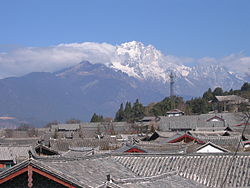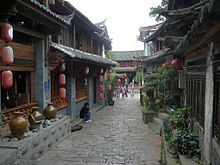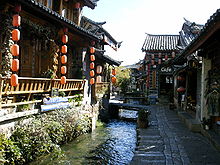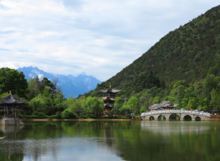Lijiang
| 丽江 市 Lijiang |
||
|---|---|---|
|
|
||
| Coordinates | 26 ° 53 ' N , 100 ° 14' E | |

|
||
| Basic data | ||
| Country | People's Republic of China | |
| Yunnan | ||
| region | Southwest China | |
| ISO 3166-2 | CN-YN | |
| surface | 20,554 km² | |
| Residents | 1,280,000 (2015) | |
| density | 62.3 Ew. / km² | |
| Post Code | 674100 | |
| Website | www.lijiang.gov.cn | |
| Others | ||
| status | District-free city | |
| Time zone | China Standard Time (CST) UTC +8 |
|
|
View over the roofs of Lijiang to the Yulong Xueshan (
玉龙 雪山 - "Jade Dragon Snow Mountain", 5596 meters)
|
||
Lijiang ( Chinese麗江 市 / 丽江 市Pinyin Lìjiāng Shì, obsolete after Stange Likiang, "city on the beautiful river") is a district-free city in the Yunnan Province of the People's Republic of China .
Administrative district and autonomous district
Until December 26, 2002, there was Lijiang Governorate (丽江 地区) and Lijiang Autonomous County of the Naxi (丽江 纳西族 自治县). Both were dissolved by Resolution No. 122/2002 of the State Council of the PRC. The content of the resolution is:
- Lijiang Governorate is dissolved and the prefecture-level city of Lijiang (丽江 市) is established. The administrative area of the former Lijiang District is also the administrative area of Lijiang City. The city creates the Gucheng district (古城 区, "old town"). The Gucheng District is made up of Dayan Township (大 研 镇), Longshan Township (龙 山乡), Qihe Township (七 河乡), Dadong Township (大 东乡), Jinshan Township (金山 白族 乡) and the Jinjiang Bai Township (金 江 白族 乡) together (all formerly part of the Lijiang Autonomous County of the Naxi). The Gucheng District is the seat of the People's Government of Lijiang City. The seat of the People's Government of the Gucheng District is the Dayan Township (formerly the seat of the People's Government of the Lijiang Autonomous County of Naxi).
- The Lijiang Autonomous County of Naxi is dissolved and the Yulong Autonomous County of Naxi (玉龙 纳西族 自治县) is established. The Naxi Yulong Autonomous County is made up of Huangshan Township (黄山 镇), Shigu Township (石鼓 镇), Judian Township (巨 甸 镇), Baisha Township (白沙 乡), Lashi Township (拉 市 乡) ), Tai'an Township (太 安 乡), Longpan Township (龙蟠 乡), Jinzhuang Township (金 庄乡), Ludian Township (鲁甸 乡), Tacheng Township (塔 城乡), the township Daju (大 具 乡), Baoshan Town (宝山 乡), Fengke Town (奉 科 乡), Mingyin Town (音 乡), Shitou Township of Bai (石头 白族 乡), Renhe Township of Lisu (仁 和 傈 僳 族 乡), the municipality of Liming the Lisu (黎明 傈 僳 族 乡) and the municipality of Jiuhe the Bai (九 河 白族 乡) together (all formerly part of the Lijiang Autonomous County of the Naxi). Huangshan Township is the seat of the People's Government of Yulong Autonomous County in Naxi.
Lijiang City has a total area of 21,219 km². Since the old town (Gucheng district) was added to the UNESCO World Heritage List in 1997 , it has enjoyed great popularity with domestic and foreign visitors.
geography
The city is located on the southeastern foothills of the Himalayas , in the northeast of the province on the middle reaches of the Jinsha River. Due to its location on a plateau 2,600 meters above sea level, it has a pleasant climate all year round .
Fertile fields extend southeast of the Gucheng district. Lijiang is also in the immediate vicinity of the Yulong Snow Mountains (玉龙 雪山, Yùlóng Xuěshān, "Jade Dragon Snow Mountains"), which form the interface between the Qinghai-Tibet Plateau (青藏高原, Qīng Zàng Gāoyuán) and the Yunnan-Guizhou Plateau (云贵高原, Yún Guì Gāoyuán), and has a chain of glaciated mountain peaks. The southernmost point of this mountain range, 5,596 meters high, is also known as the "jade pillar that towers into the sky".
Administrative structure
The prefecture-level city of Lijiang is composed of a municipality, two counties and two autonomous counties at the county level:
- Gucheng district (古城 区, "old town"), capital: Dayan community (大 研 镇), 1,127 km², 140,000 inhabitants (2002),
- District Yongsheng (永胜县), capital: greater community Yongbei (永北镇), km² 5099, 380,000 inhabitants (2002)
- Huaping district (华坪 县), main town: Zhongxin municipality (中心 镇), 2,266 km², 150,000 inhabitants (2002),
- Yulong Autonomous County of the Naxi (玉龙 纳西族 自治县), capital: Huangshan Municipality (黄山 镇), 6,521 km², 210,000 inhabitants (2002),
- Autonomous district of Ninglang der Yi (宁蒗 彝族 自治县), capital: Daxing municipality (大兴 镇), 6,206 km², 230,000 inhabitants (2002).
Ethnic breakdown of the population of Lijiang (2000)
At the census in 2000 Lijiang had 1,126,646 inhabitants (population density: 53.1 inh / km²). It is noteworthy that the Han Chinese, who make up the vast majority in most Chinese municipalities, remain below 50 percent of the population here.
| Name of the people | Residents | proportion of |
|---|---|---|
| Han | 481.142 | 42.7% |
| Naxi | 231.057 | 20.51% |
| Yi | 210.431 | 18.68% |
| Lisu | 108,347 | 9.62% |
| Bai | 48,419 | 4.3% |
| Primi | 15,768 | 1.4% |
| Dai | 11,258 | 1.0% |
| Miao | 6,373 | 0.56% |
| Tibetans | 4.177 | 0.37% |
| Hui | 4.173 | 0.37% |
| Zhuang | 3,916 | 0.35% |
| Li | 289 | 0.03% |
| Mongols | 209 | 0.02% |
| Do | 188 | 0.02% |
| Manchu | 155 | 0.01% |
| Bouyei | 123 | 0.01% |
| Others | 621 | 0.05% |
history
In the area around Lijiang (in the Baisha settlement) was the capital of the Naxi Kingdom. In the middle of the 13th century , the region was conquered by the Yuan Dynasty under Kublai Khan . Lijiang was founded under this name at this time.
It developed into an important trading center between Tibet and Yunnan, which it is to this day.
In the course of the eight hundred year history of the city, an irrigation system was also set up, which still works today.
During the Second Sino-Japanese War , Lijiang was a base for volunteer pilots who supported China's battle against Japan .
About a third of the city was destroyed in an earthquake in February 1996. While many traditional houses survived the quake, many more modern concrete structures collapsed. After that, with the development of tourism in mind, the city center was tastefully rebuilt in a traditional style.
Since 1997, the old city center of Lijiang has the status of UNESCO - World Heritage Site . UNESCO justifies this with three criteria: In Lijiang, the results of over 800 years of cultural exchange are visible, the old town quarters reflect the living traditions of the local population groups and the way in which the old town of Lijiang includes the surrounding mountains and rivers is an outstanding one Example of the ingenuity of human land use taking into account the harmony between humans and nature. At the same time, however, the massive increase in tourist visitors to Lijiang's old town has also led to conflicts between conservation efforts and economic development. UNESCO recommends balancing both in management plans.
A town partnership has existed with the German town of Bad Homburg vor der Höhe since 2011.
Culture and sights
Lijiang's old town, Dayan Township, is criss-crossed by narrow cobblestone streets and a network of canals. It is one of the best preserved old towns in China. The name Dayan comes from the fact that the old town looks like a large ink stone from a distance.
The old houses mostly rest on stone foundations and walls made of whitewashed adobe bricks, have doors, balconies and shutters made of red wood and typically curved tile roofs.
Many of the stone bridges are centuries old and have survived both wars and earthquakes.
Dayan is the center of the Naxi minority ( Chinese:纳西 少数 民族Pinyin Nàxī shǎoshù mínzú), which is descended from Tibetan nomads who have settled in this area since the 10th century.
The Naxi produced the Dongba culture ( Chinese東巴 文化 / 东巴 文化Pinyin Dōngbā Wénhuà). A separate script was developed within the Dongba culture and literary works were created. The documents of the Dongba culture were included in the UNESCO list of the World Document Heritage because they are testimony to how the Naxi designed a writing system with over 2000 pictograms to give voice to their beliefs and traditions.
The Dongba culture can be learned in Lijiang through the construction, the script and the belief. There are several orchestras for traditional Naxi music and lively folklore in the surrounding villages.
The houses of the Naxi are usually built around a courtyard and lavishly decorated with mythological figures and fish. The houses are very important to the Naxi and a lot of money is spent on maintaining them.
The center of the city is Sifang , the market square. Goods from Tibet and southern Yunnan used to be handled here. Today, arts and crafts items are sold to tourists. South of Sifang there are the most traditional neighborhoods and markets, while the corners north of Sifang have been prepared for tourists at great expense.
To the west of the Sifang, one climbs to the Lion Hill (狮子山, Shīzi Shān), on the summit of which sits the 22-meter-high Wangu Lou , from which one can enjoy an excellent view over Lijiang.
North of the city center is the Black Dragon Pond Park (黑 龙潭 公园, Hēilóngtán Gōngyuán). The Deyue Pavilion in the middle of the Jade Fountain Lake with the Jade Dragon Snow Mountains in the background is particularly photogenic .
In the park area there is also a cultural institute where the manuscripts of the Naxi priests are translated in order to preserve them for posterity. At the north end of the park you can see the remains of Lijiang's once largest temple complex, Fuguo Si (福 国寺, Fúguó Sì), which were brought here in the 1970s.
Fifteen kilometers from the old town is the 5596 meter high Yulong Snow Mountains (玉龙 雪山, Yùlóng Xuěshān, "Jade Dragon Snow Mountains"). You can "climb" the mountain up to the snow line by cable car.
traffic
The airport of Lijiang , 25 km south on the road to Dali and was 1994 opened. There are important land connections to the south to Dali (150 km) and Kunming (600 km) and to the north ( Sichuan and Tibet ).
A new railway line, which was built between December 2004 and September 2009 as part of China's go-west strategy , connects Lijiang with Dali. It runs on the eastern side of Erhai Lake and has a total length of 167 km. A four-hour bus journey can be replaced by a 1.5 hour train journey.
For excursions in the area, where there are some traditional settlements and Tibetan monasteries, a bicycle is recommended.
Web links
- Lijiang City Official Website (丽江) Chinese, accessed June 30, 2016 - lijiang.gov.cn
- Lijiang (丽江) Chinese news and information , accessed June 30, 2016 - lijiang.cn
- Image gallery of QT Luong
- Entry on the UNESCO World Heritage Center website ( English and French ).
Individual evidence
- ↑ a b UNESCO World Heritage Center: Old Town of Lijiang. Retrieved March 30, 2017 (English).
- ↑ Unesco. Retrieved March 30, 2017 .
- ↑ Ancient Naxi Dongba Literature Manuscripts | United Nations Educational, Scientific and Cultural Organization. Retrieved March 30, 2017 (English).
- ^ Dali-Lijiang Railway Project. ADB Asia Development Bank, archived from the original on May 26, 2009 ; accessed on April 4, 2010 (English).
- ^ Dali-Lijiang Railway opens to traffic. China Daily, September 28, 2009, accessed April 4, 2010 .







